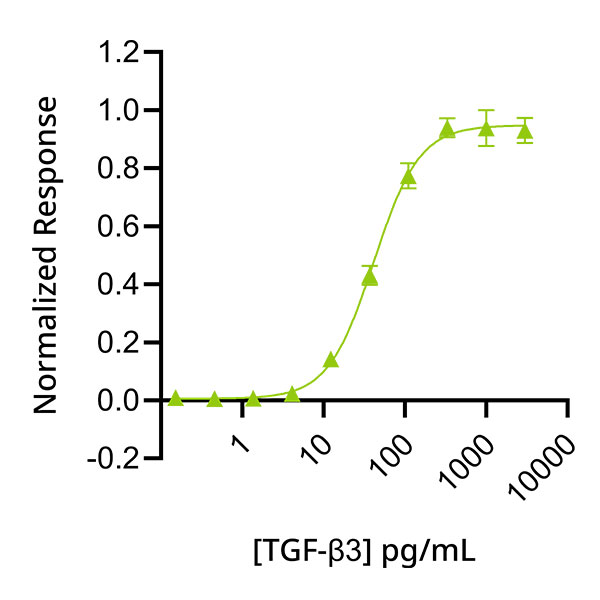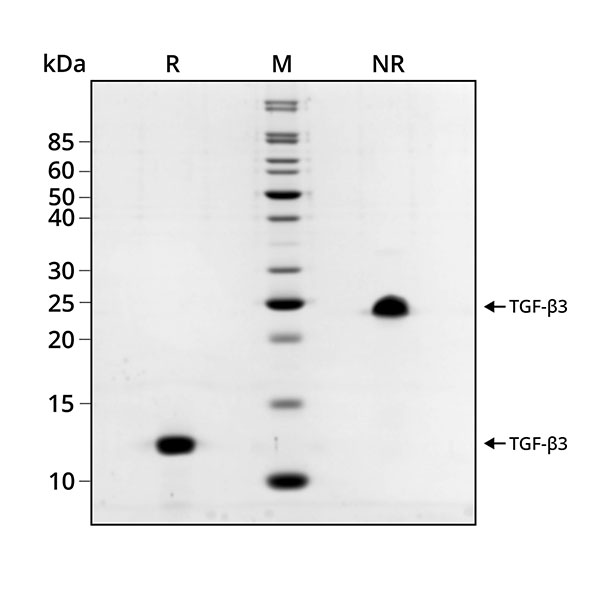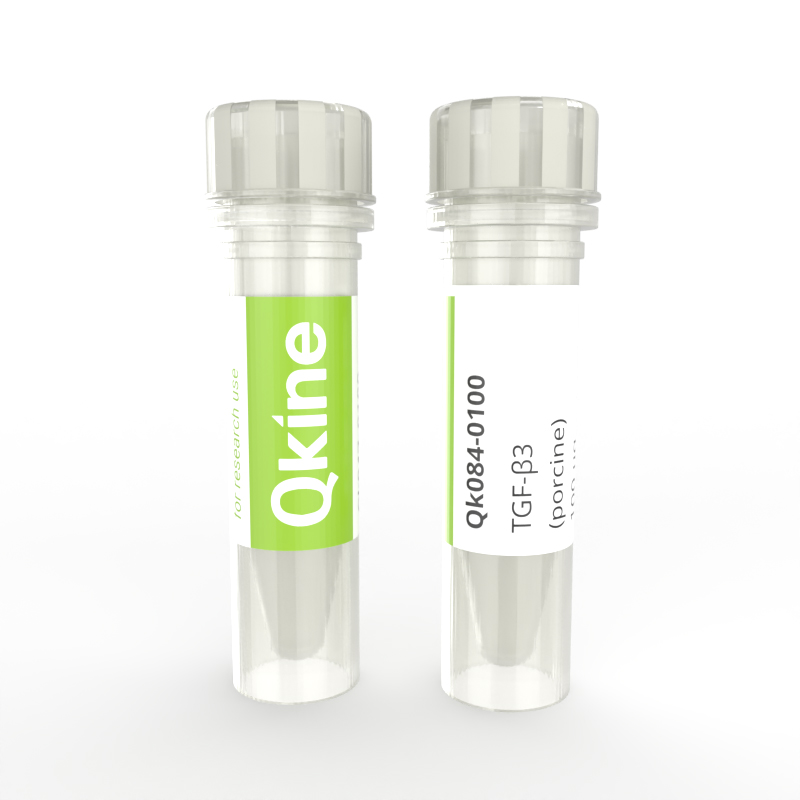Currency
Recombinant porcine TGF-β3 protein (Qk084)
Porcine TGF beta 3 protein is a member of the Transforming Growth Factor family, a family involved in regulating cell survival, proliferation and differentiation.
Qkine is dedicated to supporting the cellular agriculture industry by manufacturing high-purity and bioactive growth factors that are species-specific to cultivated cultures. Porcine TGF-β3 is used in cultivated meat pluripotent stem cell maintenance medias, such as Beefy9 media.
Porcine TGF beta 3 is a protein dimer that is animal-origin free (AOF) and carrier-protein free (CF).
Orders are typically shipped same or next day (except Friday).
Easy world-wide ordering, direct or through our distributors.
1000µg will be despatched as 2 x 500µg
Fast and free shipping.
Buy online with secure credit card or purchase order.
For any questions, please email orders@qkine.com
Summary
Highly pure porcine protein (UniProt number: P15203)
>98%, by SDS-PAGE quantitative densitometry
Source: Expressed in E. coli
25 kDa, dimer
Animal origin-free (AOF) and carrier protein-free
Manufactured in Cambridge, UK
Lyophilized from ACN/TFA
Resuspend in 10mM HCl at >100 µg/ml (provided with protein and free of charge), prepare single-use aliquots, add carrier protein if desired and store frozen at -20°C or -80°C
Featured applications
Maintenance and expansion of porcine iPSCs and ESCs
Differentiation of iPSCs towards mesodermal lineages
Culture of porcine muscle stem cells
Regulation of extracellular matrix synthesis
Embryonic morphogenesis
Inclusion in cultivated meat media
Transforming growth factor beta-3
TGF-b3
TGFB3
Prepro-transforming growth factor beta-3
Arrhythmogenic right ventricular dysplasia 1 (ARVD, ARVD1)
Porcine
Bioactivity

Recombinant porcine TGF-β3 activity is determined using a TGF-β3-responsive luciferase assay. Transfected HEK293 cells are treated in triplicate with a serial dilution of porcine TGF-β3 for 6 hours. Firefly activity is measured and normalised to the control Renilla luciferase activity. Data from Qk084 lot 204635. EC50 = 41 pg/mL (1.6 pM)
Purity

Recombinant porcine TGF-β3 migrates at approximately 12.6 kDa (monomer) in reduced (R) and at approximately 25 kDa (dimer) in non-reduced (NR) conditions. No contaminating protein bands are present. The purified recombinant protein (3 µg) was resolved using 15% w/v SDS-PAGE in reduced (+β-mercaptoethanol, R) and non-reduced (NR) conditions and stained with Coomassie Brilliant Blue R250. Data from Qk084 lot #204635.
Further quality assays
Mass spectrometry, single species with the expected mass
Endotoxin: <0.005 EU/μg protein (below the level of detection)
Recovery from stock vial: >95%
We are a company founded and run by scientists to provide a service and support innovation in stem cell biology and regenerative medicine. All our products are exceptionally high purity, with complete characterisation and bioactivity analysis on every lot.
Protein background
Transforming growth factor beta 3 (TGF-β3) is a member of the TGF-β family (and TGF-β superfamily). Like other TGF-β family members – TGF-β1 and 2 – TGF-β3 signals via receptor complexes consisting of Type I and Type II serine/threonine kinase receptors, activating intracellular SMAD transcription factors. [3]
The TGF-β family have a high degree of overlap/redundancy and regulate a variety of cellular functions, including cell survival, proliferation, and differentiation.[1] TGF beta 3 has isoform-specific roles in embryonic palate fusion4 and wound healing.[5]
In culture, TGF beta 3 is often used in porcine pluripotent cell maintenance. TGF-β3 is a component of B8 media – the low-cost weekend-free iPSC media developed in the lab of Paul Burridge, Northwestern University.[2] In the development of B8 media, Kuo et al.[2] proved that while TGF-β1 can maintain iPSCs at 2ng/ml, TGF-β3 can maintain iPSCs in as little as 0.1ng/ml, making it a cost-effective alternative to TGF-β1. This holds great promise for the development of cultivated porcine protocols and serum-free media development in the cellular agriculture industry, aiding the ultimate price-point requirements of the industry.
FAQ
TGF-β3 is a growth factor involved in tissue development, wound healing, and immune regulation, crucial for iPSC and ESC proliferation and differentiation.
TGF-β3 is found in various tissues throughout the body, including the skin, bones, blood vessels, and immune cells.
Yes, TGF-β3 is a cytokine.
The TGF-β3 gene encodes the transforming growth factor beta 3 protein.
TGF-β3 binds to TGF-β receptors. This triggers intracellular signaling pathways that regulate gene expression, influencing cellular processes.
The TGF-β3 receptor serves as a cell surface receptor for the TGF-β3 ligand. It plays a crucial role in transmitting signals from the extracellular environment to the interior of the cell upon ligand binding and initiating intracellular signaling cascades that regulate gene expression.
The TGF-β3 pathway is a series of intracellular signaling events triggered by the binding of TGF-β3 ligands to their cell surface receptors. Upon ligand binding, the TGF-β3 receptors undergo phosphorylation and activation, leading to the activation of downstream signaling molecules such as Smad proteins. These Smad proteins translocate into the nucleus, where they regulate the expression of target genes involved in various cellular processes such as proliferation and differentiation.
TGF-β3 regulates cell behavior, promoting differentiation and wound healing. It is often used in tissue engineering, cellular agriculture industries for cultivated pork, and immune modulation.
Our products are for research use only and not for diagnostic or therapeutic use. Products are not for resale.



What others are saying
There are no contributions yet.